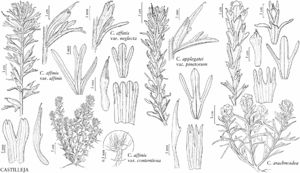Castilleja applegatei var. pinetorum
Intermount. Fl. 4: 486. 1984.
Herbs 1.2–6 dm. Stems unbranched, sometimes branched. Leaves linear to broadly lanceolate, 1–6 cm, 0–3 (–5) -lobed, apex narrowly acute to acuminate. Inflorescences 4–12 (–21 in fruit) × 1–4 cm; bracts distally red, red-orange, or scarlet, sometimes orange, pale orange, or yellow, rarely with a narrow yellowish band medially, 3 (–7) -lobed, central lobe apex obtuse, others obtuse to acute. Calyces proximally green, yellow, or whitish with green veins, lobe apices colored as bracts, sometimes with a yellow band between green and other color, 15–25 mm; abaxial and adaxial clefts 4–9 mm, 33–50% of calyx length, lateral 2.5–5 mm, 12–20% of calyx length; lobe apex acute to acuminate. Corollas 25–35 mm; tube 15–20 mm; beak 9–20 mm. 2n = 24, 48.
Phenology: Flowering (Apr–)May–Aug.
Habitat: Open forests, rocky slopes, canyons, sagebrush hillsides.
Elevation: 300–3600 m.
Distribution
Calif., Idaho, Nev., Oreg.
Discussion
Variety pinetorum is the most widespread and common representative of the Castilleja applegatei complex. It replaces var. breweri in the Sierra Nevada at low to moderate elevations. On the western flank of Steens Mountain, Harney County, Oregon, var. pinetorum occurs almost exclusively in a yellow-bracted form and has been confused with C. glandulifera. Variety pinetorum hybridizes with C. peckiana in Harney County, Oregon.
Selected References
None.
Lower Taxa
"dm" is not declared as a valid unit of measurement for this property.
